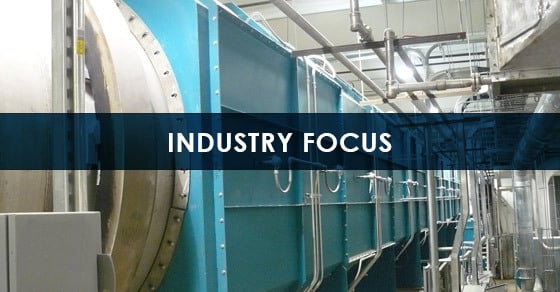Catalysts have become a cornerstone of modern industrial processing, bringing otherwise-out-of-reach processes into the realm of practicality, maximizing the efficiency of reactions, and promoting more sustainable industrial processes; the extent to which catalysts impact modern industry are nearly immeasurable.
The effectiveness of any catalyst rests on the manufacturer’s ability to tailor the relevant qualities of the catalyst to the application at hand. A key step in reaching those parameters in the catalyst preparation process is calcination – a thermal treatment carried out in a rotary kiln.
Through calcination, catalyst producers can achieve the diverse combinations of specifications their customers require to meet their growing needs. The following information illustrates how calcination is used in catalyst preparation, and what the calcination process looks like.
About Calcination
Calcination is a thermal processing treatment used to cause chemical separation. The technique is widely applicable and subsequently used throughout various industries to manufacture and process industrial chemicals, recover valuable materials, and optimize products for their intended use, among other objectives. In fact, like catalysts, calcination makes many products and processes possible that otherwise might not be. Common examples of calcination in industry include:
Why Calcination is Used in Catalyst Preparation
Catalyst preparation involves a number of different steps to create a catalyst with the desired physical structure and chemical composition necessary for the intended application.
Calcination follows these steps as a sort of finishing process, serving multiple purposes in bringing the finished catalyst to market.
The primary reason for calcining the catalyst is to cure or “set” the actual catalyst material, typically a metal, onto the catalyst carrier or substrate, typically a ceramic-based material such as alumina. This ensures that the catalyst and substrate are well bonded and also hardens the catalyst so it can hold up under duty.
In addition, calcination also assists in:¹
- Removing impurities that could otherwise poison the catalyst
- Aiding in control of surface density
- Finalizing the surface area of the support structure
- Locking in pore structure
- Securing crystallization phase
- Activating wetting and spreading
In addition to these objectives, calcination also removes bound or crystalline water; catalysts require a moisture content of zero, and while a rotary pre-dryer will remove the bulk of the moisture, it typically does not operate at temperatures high enough to drive off chemically bound water.
A Look at the Catalyst Calcination Process
Careful control over the calcination process is essential to yielding the desired end product qualities. This starts with the calciner itself.
The Catalyst Calciner
While direct-fired kilns are available, catalyst calcination is always carried out in an indirect-fired rotary kiln, also known as a calciner.
In an indirect-fired kiln, the catalyst is kept separate from the heating medium, allowing an inert atmosphere to be maintained. If a direct-fired kiln were used, the products of combustion used to heat the kiln could contaminate the catalyst, causing it to foul or be less active.
Instead of products of combustion, the rotating kiln is sealed inside of an electrically or natural gas-heated furnace or heat shroud. This heats the shell of the kiln, which in turn heats the catalyst through contact with the shell.
The use of an indirect-fired kiln also allows for more precise control of the temperature along the length of the kiln. Because the kiln is externally heated in zones, each zone’s temperature can be tightly controlled, which is often a requirement when processing catalysts.
3D rendering of a FEECO Catalyst Calciner (Indirect-Fired Rotary Kiln)
Important Process Parameters in Catalyst Calcination
In addition to an inert atmosphere, two process variables are important in the catalyst calcination process:
Retention Time
Also known as residence time, the retention time is the amount of time the catalyst must be processed in the kiln to reach the intended results. The retention time is determined through a thermal and chemical analysis that reveals how long (and at what temperature) the material must be processed to achieve the desired outcome.
Finding the right retention time is crucial to achieving the specific parameters needed; material that is either under- or over-processed will not meet its requirements.
Temperature Profile
The temperature profile is the temperature(s) at which the catalyst is processed. Different temperatures may be used during the calcination process to control the chemical and physical changes occurring with the catalyst. As mentioned, this is typically done through the use of carefully controlled temperature zones.
Developing a Catalyst Calcination Process
The catalyst market is fairly mature, and for well-established processes and materials, testing to de-risk the project and gather data for scale-up is typically not necessary.
Where testing is necessary, is in the development of new catalysts and the optimization of existing ones. This might include trying out new materials, either for the substrate or the active catalyst, evaluating how different physical and chemical properties affect the process, and more.
Through facilities such as the FEECO Innovation Center, catalyst manufacturers can trial their intended process or product at both batch and pilot scale. The Innovation Center is unique in that it not only provides batch- and pilot-scale kilns for testing, but that agglomeration and drying can also be tested. Catalyst formulation and particle properties can also be worked out through agglomeration testing.
Conclusion
Calcination plays an essential role in manufacturing catalysts for industrial use, curing and hardening the catalyst, removing impurities, and driving off chemically bound moisture. The catalyst calcination process relies on an indirect-fired rotary kiln to allow for processing in an inert atmosphere, and for precise control over temperature zones, with retention time and temperature profile being key process parameters.
FEECO is the leading provider of custom rotary kilns for catalyst calcination. In addition to the industry’s most reliable rotary kilns, FEECO offers process testing and development services through our Innovation Center. We also provide support through a comprehensive parts and service program to keep catalyst kilns running their best. For more information on our catalyst kilns, testing services, or parts and service support, contact us today!



